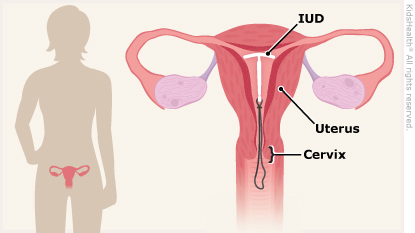Birth Control: IUDs
An IUD (intrauterine device) is a piece of T-shaped plastic, about the size of a quarter, that is placed inside the uterus to prevent pregnancy. Two types of IUDs are available: copper and hormonal. An IUD is one of the best ways to prevent pregnancy. Some types can stay in place for up to 10 years.


-
Schedule a follow-up visit to see your health care provider 6 weeks after you get the IUD so they can make sure it's in the right place.
-
It's important to use a condom every time you have sex (vaginal, oral, or anal), even when you have an IUD, because:
-
The IUD may not start working right away.
-
Condoms protect you from sexually transmitted diseases (STDs, also called STIs or sexually transmitted infections).
-
If you get an STD in the first 3 weeks after the IUD is put in, you can get a serious infection called pelvic inflammatory disease (PID).
-
Using condoms while you have an IUD makes it even less likely that you will get pregnant.
-
You can go back to school or work the day after the IUD is put in.
-
Some vaginal bleeding or spotting is normal, especially in the first 2 days after the IUD is put in. It's OK to use a pad or tampon.
-
If you have cramps or pain, and your health care provider says it's OK, you can take ibuprofen (such as Advil®, Motrin®, or a store brand) or naproxen (such as Aleve® or a store brand). Follow the directions on the label for how much to take and how often.

-
You have cramping, spotting, or irregular bleeding that lasts more than 6 weeks after getting the IUD. These symptoms usually get better after about 3–6 months, but it's still important to check in with your health care provider.
-
You have heavy bleeding (soaking through a pad or tampon every hour for more than 2 hours).
-
The strings of the IUD seem to be shorter or longer than before.
-
You have signs of an STD (such as belly pain, fever, abnormal discharge, pain when peeing or having sex, or genital warts or sores), or if you had sex without a condom and are worried you could have an STD.
-
You start any new medicines, including antibiotics and herbal or natural medicines. Some can make the hormonal IUD not work as well.

What can I expect after the IUD is put in? Irregular bleeding is common for at least 2 days after the IUD is put in. The bleeding can continue for 6 weeks or longer, but usually gets better over time. If the bleeding continues past 6 weeks, talk to your health care provider about ways to make it better.
What problems can happen? Most IUDs do not cause any problems. Very rarely, when the health care provider puts the IUD in, it can push through the wall of the uterus, or bacteria (germs) can get into the uterus and lead to pelvic inflammatory disease (PID).
Rarely, an IUD can come out of the uterus by accident. Someone might not know this has happened. If an IUD comes even part of the way out, it does not protect against pregnancy. It's important to follow up with your health care provider as instructed so they can make sure the IUD is in place.
IUDs do not cause problems with fertility (getting pregnant) after they are taken out and do not cause ectopic pregnancies (when a fertilized egg grows outside the uterus).
How do IUDs prevent pregnancy? Both copper and hormonal IUDs work by:
The hormonal IUD may also prevent ovulation (when an egg is released during the monthly cycle).
What if I have sex before the IUD is working and I don't use a condom or it breaks? Emergency contraceptive ("morning after") pills are available at drugstores without a prescription or ID. They delay ovulation (the release of an egg). This way, there is no egg for the sperm to fertilize. If the egg was already fertilized and implanted in the uterus wall, emergency contraceptive pills will not stop the pregnancy.